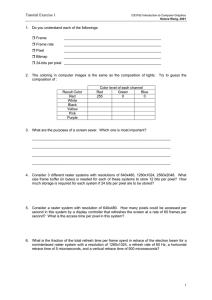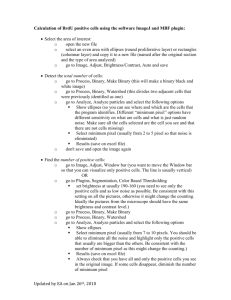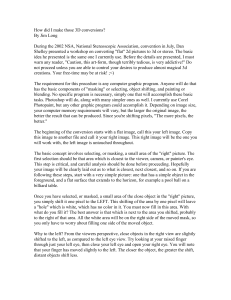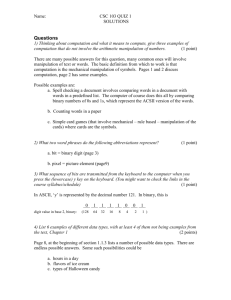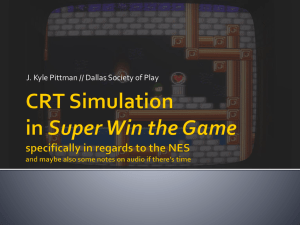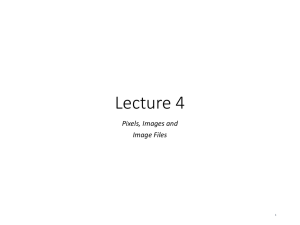Exercise 6 - Ee Oulu Fi
advertisement
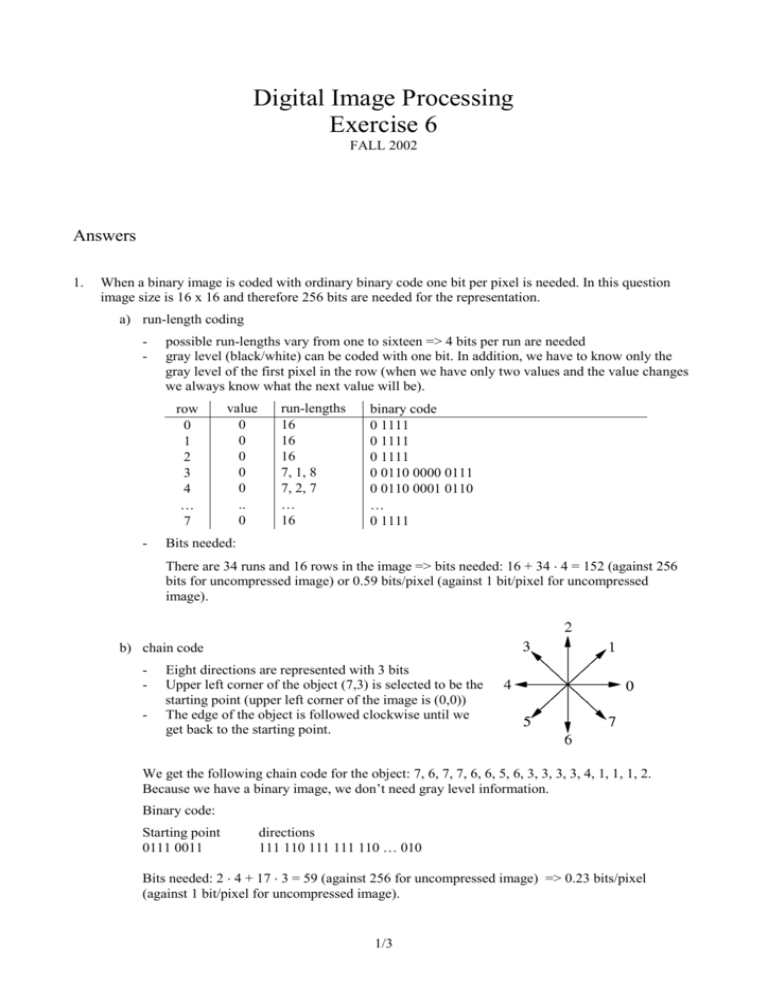
Digital Image Processing Exercise 6 FALL 2002 Answers 1. When a binary image is coded with ordinary binary code one bit per pixel is needed. In this question image size is 16 x 16 and therefore 256 bits are needed for the representation. a) run-length coding - possible run-lengths vary from one to sixteen => 4 bits per run are needed gray level (black/white) can be coded with one bit. In addition, we have to know only the gray level of the first pixel in the row (when we have only two values and the value changes we always know what the next value will be). row 0 1 2 3 4 … 7 - value 0 0 0 0 0 .. 0 run-lengths 16 16 16 7, 1, 8 7, 2, 7 … 16 binary code 0 1111 0 1111 0 1111 0 0110 0000 0111 0 0110 0001 0110 … 0 1111 Bits needed: There are 34 runs and 16 rows in the image => bits needed: 16 + 34 4 = 152 (against 256 bits for uncompressed image) or 0.59 bits/pixel (against 1 bit/pixel for uncompressed image). b) chain code - Eight directions are represented with 3 bits Upper left corner of the object (7,3) is selected to be the starting point (upper left corner of the image is (0,0)) The edge of the object is followed clockwise until we get back to the starting point. We get the following chain code for the object: 7, 6, 7, 7, 6, 6, 5, 6, 3, 3, 3, 3, 4, 1, 1, 1, 2. Because we have a binary image, we don’t need gray level information. Binary code: Starting point 0111 0011 directions 111 110 111 111 110 … 010 Bits needed: 2 4 + 17 3 = 59 (against 256 for uncompressed image) => 0.23 bits/pixel (against 1 bit/pixel for uncompressed image). 1/3 Digital Image Processing, Exercise 6, answers 2. a) It is not. Variable-length coding is based on the principle that most probable symbols (gray levels) are coded with the shortest code words and the least probable symbols are coded with the longest code words. In ideal case, the image after histogram equalization has the equal number of every pixel value (flat histogram). Though in reality there can be variations, the compression achieved by using variable-length method is unlikely worth the effort. b) Yes. For example, psycho visual, spatial and geometric redundancy. 3. Spot detection 3 x 3 masks response is 9 R w1 z1 w2 z 2 ... w9 z 9 wí z i wT z i 1 w1 when the mask is w4 w 7 w2 w5 w8 w3 w6 and zi are the corresponding gray levels in the image w9 The pixel differs from its neighbors if the response: R T The given mask R = -(z1 + z2 + z3 + z4 + z6 + z7 + z8 + z9 ) + 8 z5 1. pixel: R = -( 3 + 3 + 3 + 3 + 3 + 3 + 3 + 3 ) + 8 3 = 0 2. pixel: R = -( 3 + 3 + 4 + 3 + 0 + 3 + 3 + 3 ) + 8 3 = 2 3. pixel: R = -( 3 + 4 + 4 + 3 + 4 + 3 + 3 + 4 ) + 8 0 = -28 ….. Resulting image 0 2 -28 -4 -5 -9 -4 -1 -1 -7 35 -9 -6 -11 39 There are three pixels whose response is large or small enough (bold). Therefore there are 3 spots. 4. Line detection The size of the given image is 4x4. The responses for first two masks can be calculated in only one position. The responses for the last two masks can be calculated in two positions. First mask: (+45 line) R = 2 ( 5 + 8 + 6 + 4 ) – ( 7 + 3 + 7 +1 + 9 + 0 + 3 + 5 + 3 + 8 + 5 + 3 ) = -8 2/3 Digital Image Processing, Exercise 6, answers Second mask: (-45 line) R = 2 ( 7 + 9 + 5 + 3 ) – ( 3 + 7 + 4 + 1 + 6 + 0 + 3 + 8 + 3 + 5 + 8 + 5 ) = -5 Third mask: (vertical line) R = 2 ( 3 + 9 + 8 + 8 ) – ( 7 + 1 + 3 + 5 + 7 + 6 + 5 + 5 ) = 17 R=2(7+6+5+5)–(3+9+8+8+4+0+3+3)=8 Forth mask: (horizontal line) R = 2 ( 1 + 9 + 6 + 0 ) – ( 7 + 3 + 7 + 4 + 3 + 8 + 5 + 3 ) = -8 R=2(3+8+5+3)–(1+9+6+0+5+8+5+3)=1 There is one vertical line in the image (R = 17). The line is in the second column of the image. 3/3
